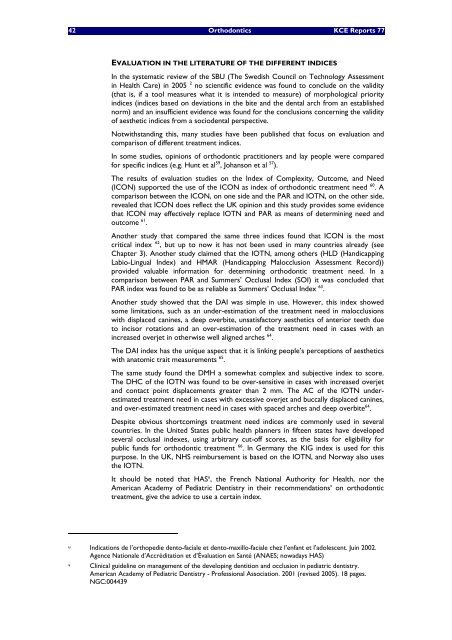The report is available in English with a Dutch summary - KCE
The report is available in English with a Dutch summary - KCE
The report is available in English with a Dutch summary - KCE
You also want an ePaper? Increase the reach of your titles
YUMPU automatically turns print PDFs into web optimized ePapers that Google loves.
42 Orthodontics <strong>KCE</strong> Reports 77<br />
EVALUATION IN THE LITERATURE OF THE DIFFERENT INDICES<br />
In the systematic review of the SBU (<strong>The</strong> Swed<strong>is</strong>h Council on Technology Assessment<br />
<strong>in</strong> Health Care) <strong>in</strong> 2005 2 no scientific evidence was found to conclude on the validity<br />
(that <strong>is</strong>, if a tool measures what it <strong>is</strong> <strong>in</strong>tended to measure) of morphological priority<br />
<strong>in</strong>dices (<strong>in</strong>dices based on deviations <strong>in</strong> the bite and the dental arch from an establ<strong>is</strong>hed<br />
norm) and an <strong>in</strong>sufficient evidence was found for the conclusions concern<strong>in</strong>g the validity<br />
of aesthetic <strong>in</strong>dices from a sociodental perspective.<br />
Not<strong>with</strong>stand<strong>in</strong>g th<strong>is</strong>, many studies have been publ<strong>is</strong>hed that focus on evaluation and<br />
compar<strong>is</strong>on of different treatment <strong>in</strong>dices.<br />
In some studies, op<strong>in</strong>ions of orthodontic practitioners and lay people were compared<br />
for specific <strong>in</strong>dices (e.g. Hunt et al 59 , Johanson et al 57 ).<br />
<strong>The</strong> results of evaluation studies on the Index of Complexity, Outcome, and Need<br />
(ICON) supported the use of the ICON as <strong>in</strong>dex of orthodontic treatment need 60 . A<br />
compar<strong>is</strong>on between the ICON, on one side and the PAR and IOTN, on the other side,<br />
revealed that ICON does reflect the UK op<strong>in</strong>ion and th<strong>is</strong> study provides some evidence<br />
that ICON may effectively replace IOTN and PAR as means of determ<strong>in</strong><strong>in</strong>g need and<br />
outcome 61 .<br />
Another study that compared the same three <strong>in</strong>dices found that ICON <strong>is</strong> the most<br />
critical <strong>in</strong>dex 62 , but up to now it has not been used <strong>in</strong> many countries already (see<br />
Chapter 3). Another study claimed that the IOTN, among others (HLD (Handicapp<strong>in</strong>g<br />
Labio-L<strong>in</strong>gual Index) and HMAR (Handicapp<strong>in</strong>g Malocclusion Assessment Record))<br />
provided valuable <strong>in</strong>formation for determ<strong>in</strong><strong>in</strong>g orthodontic treatment need. In a<br />
compar<strong>is</strong>on between PAR and Summers’ Occlusal Index (SOI) it was concluded that<br />
PAR <strong>in</strong>dex was found to be as reliable as Summers’ Occlusal Index 63 .<br />
Another study showed that the DAI was simple <strong>in</strong> use. However, th<strong>is</strong> <strong>in</strong>dex showed<br />
some limitations, such as an under-estimation of the treatment need <strong>in</strong> malocclusions<br />
<strong>with</strong> d<strong>is</strong>placed can<strong>in</strong>es, a deep overbite, unsat<strong>is</strong>factory aesthetics of anterior teeth due<br />
to <strong>in</strong>c<strong>is</strong>or rotations and an over-estimation of the treatment need <strong>in</strong> cases <strong>with</strong> an<br />
<strong>in</strong>creased overjet <strong>in</strong> otherw<strong>is</strong>e well aligned arches 64 .<br />
<strong>The</strong> DAI <strong>in</strong>dex has the unique aspect that it <strong>is</strong> l<strong>in</strong>k<strong>in</strong>g people’s perceptions of aesthetics<br />
<strong>with</strong> anatomic trait measurements 65 .<br />
<strong>The</strong> same study found the DMH a somewhat complex and subjective <strong>in</strong>dex to score.<br />
<strong>The</strong> DHC of the IOTN was found to be over-sensitive <strong>in</strong> cases <strong>with</strong> <strong>in</strong>creased overjet<br />
and contact po<strong>in</strong>t d<strong>is</strong>placements greater than 2 mm. <strong>The</strong> AC of the IOTN underestimated<br />
treatment need <strong>in</strong> cases <strong>with</strong> excessive overjet and buccally d<strong>is</strong>placed can<strong>in</strong>es,<br />
and over-estimated treatment need <strong>in</strong> cases <strong>with</strong> spaced arches and deep overbite 64 .<br />
Despite obvious shortcom<strong>in</strong>gs treatment need <strong>in</strong>dices are commonly used <strong>in</strong> several<br />
countries. In the United States public health planners <strong>in</strong> fifteen states have developed<br />
several occlusal <strong>in</strong>dexes, us<strong>in</strong>g arbitrary cut-off scores, as the bas<strong>is</strong> for eligibility for<br />
public funds for orthodontic treatment 66 . In Germany the KIG <strong>in</strong>dex <strong>is</strong> used for th<strong>is</strong><br />
purpose. In the UK, NHS reimbursement <strong>is</strong> based on the IOTN, and Norway also uses<br />
the IOTN.<br />
It should be noted that HAS u , the French National Authority for Health, nor the<br />
American Academy of Pediatric Dent<strong>is</strong>try <strong>in</strong> their recommendations v on orthodontic<br />
treatment, give the advice to use a certa<strong>in</strong> <strong>in</strong>dex.<br />
u Indications de l’orthopedie dento-faciale et dento-maxillo-faciale chez l’enfant et l’adolescent. Ju<strong>in</strong> 2002.<br />
Agence Nationale d’Accréditation et d’Évaluation en Santé (ANAES; nowadays HAS)<br />
v Cl<strong>in</strong>ical guidel<strong>in</strong>e on management of the develop<strong>in</strong>g dentition and occlusion <strong>in</strong> pediatric dent<strong>is</strong>try.<br />
American Academy of Pediatric Dent<strong>is</strong>try - Professional Association. 2001 (rev<strong>is</strong>ed 2005). 18 pages.<br />
NGC:004439
















